Advertisement
Blog Archive
- ► 2021 (1)
- ► 2019 (3)
- ► 2017 (1)
- ► 2016 (7)
- ► 2015 (5)
- ► 2014 (26)
- ▼ 2013 (40)
- ► 2012 (34)
Frequency Modulation
Frequency Modulation - FM
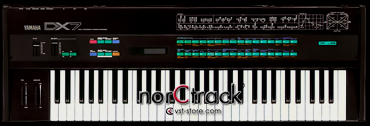
Frequency Modulation, FM-synthesis - this type of synthesis, in which the tone is formed by the influence of one simple wave to another in order to change its frequency. Under the influence of frequency modulation spectral occur more rich and complex sounds that can not get with other types of synthesis.
Through frequency modulation is almost impossible to recreate the sounds of live acoustic instruments such as piano, saxophone, violin, etc... To some extent, to simulate the sound can be approached, and thus get unique synthetic alternatives acoustic sounds without claiming a full simulation. However, the most interesting frequency modulation manifests itself as an individual or on a similar type of synthesis. Thanks to it is possible to obtain a unique, often unpredictable sounds that can enrich the palette of your arrangements or music.
History
The principle of frequency modulation - FM described in 1933 Edwin Armstrong, United States, synthesis technology developed by frequency modulation John Chowning in 1973. In 1975, this design was patented by Stanford University, and in 1977 all the rights to it received Yamaha, which soon as entrenched monopoly in this type of synthesis. Since that time, the Yamaha was the only company who had a license to use the designs of John Chowning. However, in 1995 the patent term has expired, and frequency modulation capabilities were equipped with synthesizers and other companies. During this period the patent brought a Yamaha 20 million dollars. It is noteworthy that before the invention of Chowning this algorithm, elements of frequency modulation applied in their synthesizers Don Buchla. Some of the modules of its modular systems were equipped with modulation oscillators with which it was possible to change the signal by other oscillators of frequency and amplitude modulation. Unlike Yamaha technology, Buchla has proposed analog solutions. Well, it was back in the mid 60-ies of the 20th century.
Background and Concepts
 The effects of the modulation signal is called to another in order to change its shape. A signal carrying modulation, a modulation is called, and the signal which is subjected to modulation of - carriers. There are different types of signal modulation. The most commonly used in synthesizers by high-frequency modulation oscillator (LFO). Depending on the direction of the modulation via LFO, for example, you can get a vibrato effect adjustment (if exposure occurs to the signal frequency), volume (affecting the amplitude is also called tremolo) or timbre (the impact on the spectrum by the filter). However, despite the great importance of high-frequency modulation oscillator for performing expression, it is the most primitive example of modulation. FM-synthesis involves a more complex system of interaction wave generators, synthesizers and usually this type is used for at least 4 oscillators with the filing of Yamaha herein referred to as "operators."
The effects of the modulation signal is called to another in order to change its shape. A signal carrying modulation, a modulation is called, and the signal which is subjected to modulation of - carriers. There are different types of signal modulation. The most commonly used in synthesizers by high-frequency modulation oscillator (LFO). Depending on the direction of the modulation via LFO, for example, you can get a vibrato effect adjustment (if exposure occurs to the signal frequency), volume (affecting the amplitude is also called tremolo) or timbre (the impact on the spectrum by the filter). However, despite the great importance of high-frequency modulation oscillator for performing expression, it is the most primitive example of modulation. FM-synthesis involves a more complex system of interaction wave generators, synthesizers and usually this type is used for at least 4 oscillators with the filing of Yamaha herein referred to as "operators."
Technology
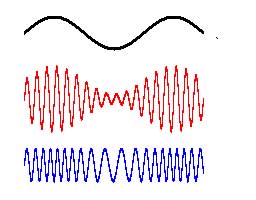 In order to understand what is happening with the sound wave under the influence of frequency modulation, and how it differs from the amplitude, just look at the picture. In the first case, we see that a particular function changes the oscillation amplitude of the carrier wave, and the second - the frequency. Unlike the modulation means LFO, wherein the frequency of the baseband signal is usually perceived Ostaetsya beyond the range of human ear, in the case of FM-modulator synthesis itself falls within this range. And since each of the participating operators can modulate the other, there is a huge variety of possible tonal shades. One complicating signal by frequency modulation of a different, second in turn acts on the third, and so on. Obviously, for such complex operations capabilities of analog synthesizers were too scarce, and because the formation and development of the FM synthesis was only possible with the advent of the era of digital synthesizers.
In order to understand what is happening with the sound wave under the influence of frequency modulation, and how it differs from the amplitude, just look at the picture. In the first case, we see that a particular function changes the oscillation amplitude of the carrier wave, and the second - the frequency. Unlike the modulation means LFO, wherein the frequency of the baseband signal is usually perceived Ostaetsya beyond the range of human ear, in the case of FM-modulator synthesis itself falls within this range. And since each of the participating operators can modulate the other, there is a huge variety of possible tonal shades. One complicating signal by frequency modulation of a different, second in turn acts on the third, and so on. Obviously, for such complex operations capabilities of analog synthesizers were too scarce, and because the formation and development of the FM synthesis was only possible with the advent of the era of digital synthesizers.
Instruments
The first appearance of the frequency modulation synth on the market is associated with tool Synclavier Company New England Digital (NED) in 1975. However, in the early '80s Yamaha produces one of the most important stories for sintezatorostroeniya and electronic music in general tool - Yamaha DX7 using FM-synthesis technology. DX7 sound is generated by the interaction of two operators given algorithms.
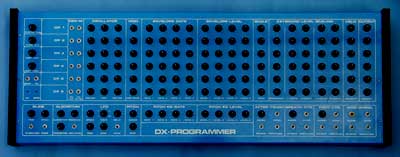 Each operator generates a sine wave Frequency setting. Opportunity to obtain a wide range of sounds, polyphony 16 voices, stable operation, light weight and affordable price - all these factors have made "seven" best selling tool in the world, and a company Yamaha - pushed into industry leaders keyboards. The disadvantages of this tool include many programming complexity. Indeed, the work with this tool has nothing to do with the programming of analog synthesizers, but with certain skills and experience of the result can be very interesting. However, the main feature of FM-synthesis was always unpredictable results - you can get a lot of good sounds, but almost impossible to predict what will result experiments. Attempt to solve the problem of software synthesizers DX Series has taken firm Jellinghouse Music Systems (JMS), by launching the programmer (see photo). This device gives you access to virtually all the usual synthesis parameters for all sound designers method. Unfortunately, these devices were produced only 25 pieces, and buy a copy of it is not practical.
Each operator generates a sine wave Frequency setting. Opportunity to obtain a wide range of sounds, polyphony 16 voices, stable operation, light weight and affordable price - all these factors have made "seven" best selling tool in the world, and a company Yamaha - pushed into industry leaders keyboards. The disadvantages of this tool include many programming complexity. Indeed, the work with this tool has nothing to do with the programming of analog synthesizers, but with certain skills and experience of the result can be very interesting. However, the main feature of FM-synthesis was always unpredictable results - you can get a lot of good sounds, but almost impossible to predict what will result experiments. Attempt to solve the problem of software synthesizers DX Series has taken firm Jellinghouse Music Systems (JMS), by launching the programmer (see photo). This device gives you access to virtually all the usual synthesis parameters for all sound designers method. Unfortunately, these devices were produced only 25 pieces, and buy a copy of it is not practical.
Later followed by various modifications of the DX7, including desktop version TX7, multitimbral keyboards version DX7S, DX7IID, DX7IIFD and rackmount TX802, and other tools with a different number of operators (for example, the model and its DX11 rackmount version TX81Z have 4 operators). Another model of the same series, DX5, had two tone generator DX7 in one case, and rack monster TX816 - once already eight!
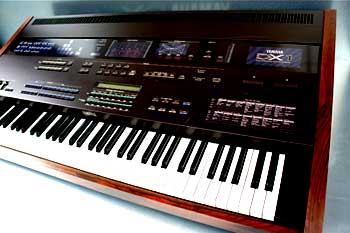 Also, was released monst synthesizer with keyboard and shestioktavnoy polnovzveshennoy extra large LED display for FM-synthesis algorithms and other parameters - Yamaha DX1 (pictured). n architecture, he was no different from DX5, it also contained two tone generator DX7. But since it was released only 140 copies DX1, its price today is 15 thousand dollars. Subsequent developments in this area Yamahas were no less interesting , in 1990 comes the legendary SY77 and its rackmount version of the TG77, and then heaped more SY99. These instruments are distinguished from its predecessors , mainly the presence of filters that give all possible instruments of subtractive synthesis as well as the use of sampled sounds (AWM), which can be mixed with the sounds synthesized by frequency modulation. In addition, these tools on board was the internal effects processor , which lacked earlier models.
Also, was released monst synthesizer with keyboard and shestioktavnoy polnovzveshennoy extra large LED display for FM-synthesis algorithms and other parameters - Yamaha DX1 (pictured). n architecture, he was no different from DX5, it also contained two tone generator DX7. But since it was released only 140 copies DX1, its price today is 15 thousand dollars. Subsequent developments in this area Yamahas were no less interesting , in 1990 comes the legendary SY77 and its rackmount version of the TG77, and then heaped more SY99. These instruments are distinguished from its predecessors , mainly the presence of filters that give all possible instruments of subtractive synthesis as well as the use of sampled sounds (AWM), which can be mixed with the sounds synthesized by frequency modulation. In addition, these tools on board was the internal effects processor , which lacked earlier models.
Vertex FM-synthesis module from Yamaha became FS1R, contains the possibility of 8-operator FM and formant synthesis (Formant Shaping Synthesis). However, as it happened with many other synthesizers late 90s, a unique scientific development has not been fully appreciated by users and a year later the tool has been discontinued.
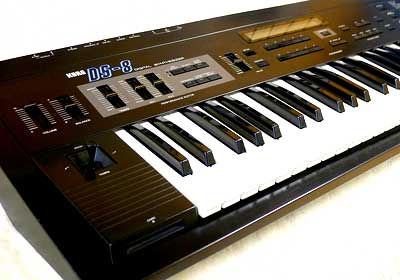 Other manufacturers also engaged FM-synthesis in their designs, however, because the patent on the technology had Yamaha, the names had to use different terminology to avoid conflicts. For example, Casio in the mid-80s released a series of synthesizers CZ, type of synthesis, similar to frequency modulation, but called Phase Distortion Synthesis (synthesis phase distortion). Phase modulation - is one form of frequency modulation. Frequency for this type of modulation remains unchanged, but there is an influence on the phase of the wave, which also allows to achieve interesting results. Korg in 1987 introduced the DS-8, working on the basis of 4-operator FM-synthesis and equipped with digital effects. Color tool is very peculiar individual, but it has some similarities to the pits - of course, thanks to the technology of synthesis
Other manufacturers also engaged FM-synthesis in their designs, however, because the patent on the technology had Yamaha, the names had to use different terminology to avoid conflicts. For example, Casio in the mid-80s released a series of synthesizers CZ, type of synthesis, similar to frequency modulation, but called Phase Distortion Synthesis (synthesis phase distortion). Phase modulation - is one form of frequency modulation. Frequency for this type of modulation remains unchanged, but there is an influence on the phase of the wave, which also allows to achieve interesting results. Korg in 1987 introduced the DS-8, working on the basis of 4-operator FM-synthesis and equipped with digital effects. Color tool is very peculiar individual, but it has some similarities to the pits - of course, thanks to the technology of synthesis
-
Tags:
- fm
- frequency modulation











Comments
PS: How are you? I am from France :)
fbnty55fe4
my email and can look out for much extra of your respective
exciting content. Make sure you update this again very soon..
RSS feed for comments to this post